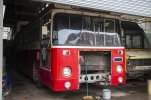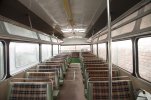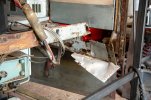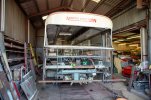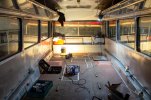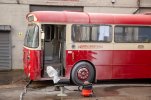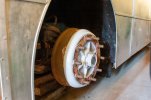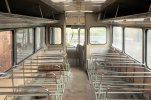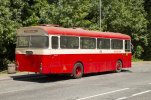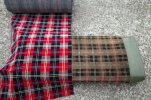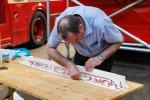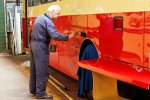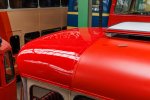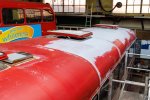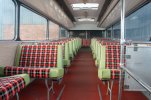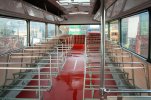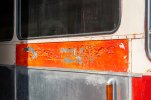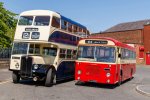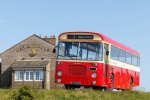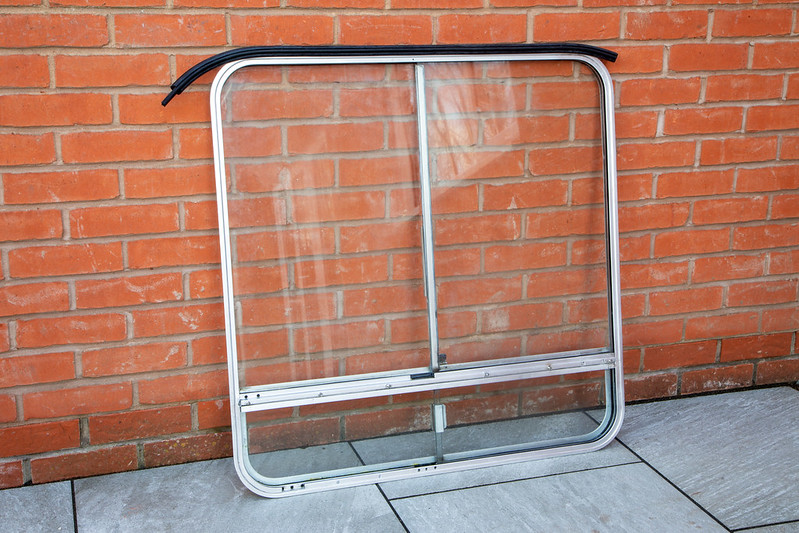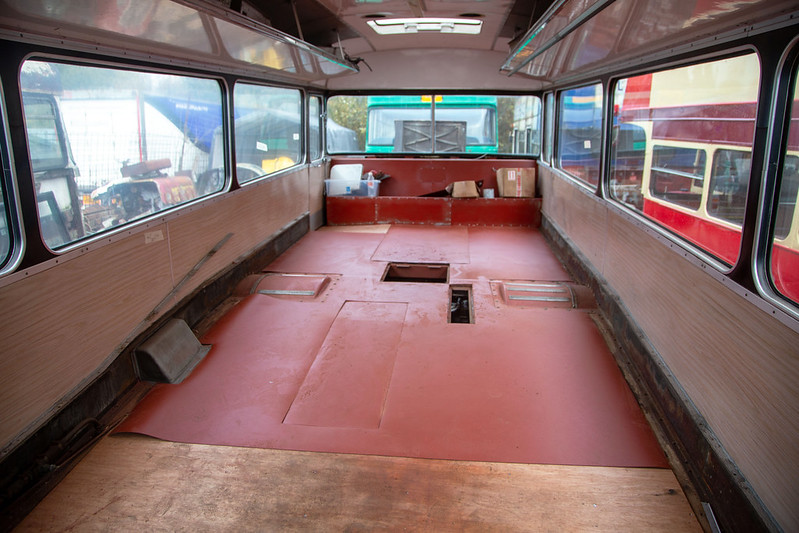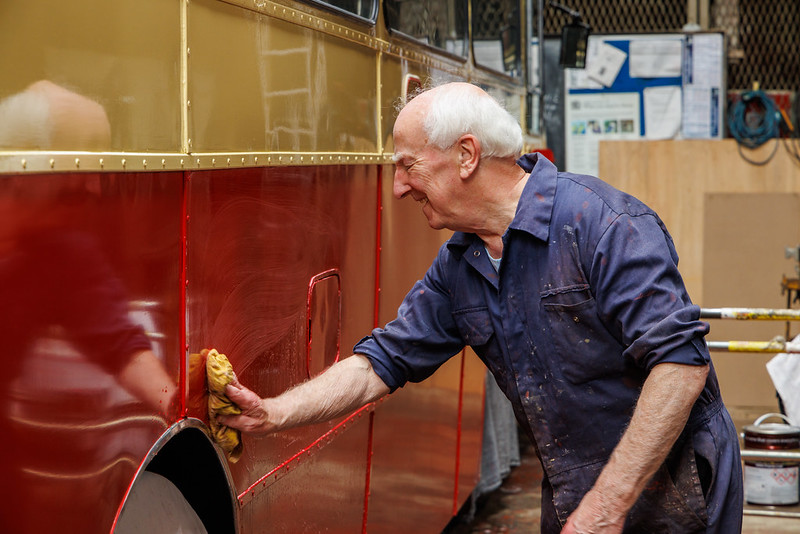jp4712
Member
- Joined
- 1 May 2009
- Messages
- 470
Purely for my amusement, and possibly yours, I thought I’d post to show you some of the work that’s required to restore a bus.
My current restoration project is a Bristol RESL6G with Marshall body, 299a (KJA299G). It came to me looking reasonably presentable, but in truth it needs plenty of work doing.
Let’s take a look at how we’ve done since I bought it in December 2017.
All photos are clickable to take you through to a bigger version on the Flickr website.
First step – does it start? The answer, with a battery charge and some fiddling is – yes it does,
 North Western 299 starts up for the first time under new ownership by Paul Williams, on Flickr
North Western 299 starts up for the first time under new ownership by Paul Williams, on Flickr
Even so it needed immediate oil and filter changes – and bear in mind that the sump takes 5 gallons (that’s 23 litres).
It was clear very quickly that it had severe cooling problems – runs of just a couple of miles resulted in water everywhere. Now this is not common for this bus, with a front radiator in the direct flow of air plus the cool-running Gardner engine. The first problem quickly became clear, which was that the header tank – sited in an incredibly inaccessible position next to the cab – had two copper pipes rubbing directly against it which over the last fifty years have worn a hole in the tank – so, with a lot of swearing and sweating, this was removed for welding.
 I blame Mr Marshall by Paul Williams, on Flickr
I blame Mr Marshall by Paul Williams, on Flickr
But this was far from the end of the cooling woes. A water pump rebuild didn’t help, so attention turned to the radiator. What we eventually found was that a breather pipe that was meant to prevent airlocks was blocked, and this resulted in a complete lack of water circulation; which meant a blocked radiator; which meant chronic overheating. So the radiator was sent off for specialist repair, at a cost of oo-er-don't-tell-the-missus.
 Bristol RE radiator, September 2018 by Paul Williams, on Flickr
Bristol RE radiator, September 2018 by Paul Williams, on Flickr
This left a gaping hole at the front that gave me an opportunity to get rid of the muck of fifty years...
 299, radiator-less, September 2018 by Paul Williams, on Flickr
299, radiator-less, September 2018 by Paul Williams, on Flickr
...and to paint all the metalwork in a fetching shade of Hammerite named 'wild thyme' which is surprisingly close to the original spec.
 Say ahhh... North Western 299, October 2018 by Paul Williams, on Flickr
Say ahhh... North Western 299, October 2018 by Paul Williams, on Flickr
The radiator came back looking like new and was installed, finally curing the cooling problems it's had for at least twenty years and probably more.
 North Western 299, November 2018 by Paul Williams, on Flickr
North Western 299, November 2018 by Paul Williams, on Flickr
Underneath at the back, a Bristol RE should have a large ‘pot’ which is an oil bath air filter. This was missing and instead was a Heath Robinson-style arrangement whose chief purpose was probably to give mirth and entertainment to the MOT tester. A new one was sourced – it needed repair but this was soon done and fitted.
 Comedy air filter set up on preserved North Western RE 299, January 2018 by Paul Williams, on Flickr
Comedy air filter set up on preserved North Western RE 299, January 2018 by Paul Williams, on Flickr
 A bit of an improvement by Paul Williams, on Flickr
A bit of an improvement by Paul Williams, on Flickr
The seat moquette is very faded, but thankfully I've been able to source a new roll of the correct pattern. Can you tell the difference?
 Seat moquette contrast, North Western 299 by Paul Williams, on Flickr
Seat moquette contrast, North Western 299 by Paul Williams, on Flickr
Re-covering the seats should be one of the last jobs, so the new moquette is in storage for now. But at some point the seat frames themselves will need to come out, all twenty-odd of them, to enable the frames to be painted (they should be grey) and new floor lino to be laid. The floor studs are almost always seized due to the action of dirt and water from mops, so it helps to wirebrush off the paint and crud and apply a squirt of penetrating oil. It also helps to have a 20-year old son to do it for you!
 299A's restoration continues, December 2019 by Paul Williams, on Flickr
299A's restoration continues, December 2019 by Paul Williams, on Flickr
Also on the inside, the front dashboard stretching right across from the entrance to the driver and then the right-side of the driver is made from glass fibre. This was a pleasant warm grey when new, but at some point drivers complaining about this creating reflections at night so the whole lot was given at least two coats of nasty black paint which now all has to come off. Paint stripper is no good - if it's strong enough to take off the paint it'll damage the glass fibre, and if it's weak enough to not cause damage then it won't take off the paint. So I experimented with soda blasting, which does the job beautifully but it's very slow and very, very messy. I did a bit myself but to be honest the thought of doing the whole lot gives me the heebie jeebies so I think I'll need to pick up the phone to a specialist supplier.
 Sodablasting 299's front dash, November 2019 by Paul Williams, on Flickr
Sodablasting 299's front dash, November 2019 by Paul Williams, on Flickr
All the paint, everywhere, needs doing again. This includes fiddly bits like the grey paint on the inside of the passenger doors. Wet-and-dry sanding in a farm yard in December is not much fun!
 299A's restoration continues, December 2019 by Paul Williams, on Flickr
299A's restoration continues, December 2019 by Paul Williams, on Flickr
On the outside, all the aluminium panels have been recorded in preparation for removal. Then the frame underneath will be scraped, rust treated and painted; and new panels fabricated.
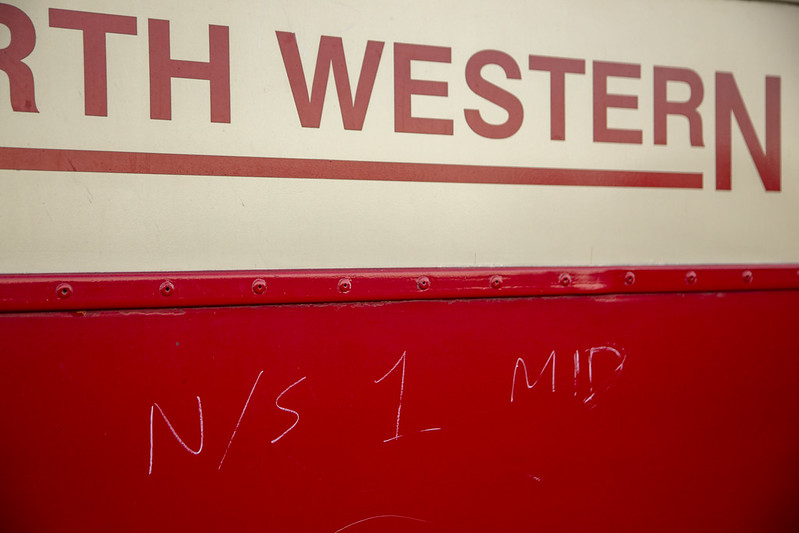 299A's restoration continues, December 2019 by Paul Williams, on Flickr
299A's restoration continues, December 2019 by Paul Williams, on Flickr
An example of a little job that makes the difference is that at some point, it lost a pair of stainless steel handrails that were sited on either side of the entrance doors. These are now reinstated using similar fittings from a scrapped 1980s bus, and you can make them out on the recent 'general view' below.
 North Western 299, Museum of Transport Greater Manchester, August 2019 by Paul Williams, on Flickr
North Western 299, Museum of Transport Greater Manchester, August 2019 by Paul Williams, on Flickr
If all this seems daunting, it is at least roadworthy now and I was able to take it for a test run.
If people are interested I’ll post more updates in due course. And if you’re in any doubt that bus restoration is a hard and expensive hobby, doubt no more!
My current restoration project is a Bristol RESL6G with Marshall body, 299a (KJA299G). It came to me looking reasonably presentable, but in truth it needs plenty of work doing.
Let’s take a look at how we’ve done since I bought it in December 2017.
All photos are clickable to take you through to a bigger version on the Flickr website.
First step – does it start? The answer, with a battery charge and some fiddling is – yes it does,
 North Western 299 starts up for the first time under new ownership by Paul Williams, on Flickr
North Western 299 starts up for the first time under new ownership by Paul Williams, on FlickrEven so it needed immediate oil and filter changes – and bear in mind that the sump takes 5 gallons (that’s 23 litres).
It was clear very quickly that it had severe cooling problems – runs of just a couple of miles resulted in water everywhere. Now this is not common for this bus, with a front radiator in the direct flow of air plus the cool-running Gardner engine. The first problem quickly became clear, which was that the header tank – sited in an incredibly inaccessible position next to the cab – had two copper pipes rubbing directly against it which over the last fifty years have worn a hole in the tank – so, with a lot of swearing and sweating, this was removed for welding.
 I blame Mr Marshall by Paul Williams, on Flickr
I blame Mr Marshall by Paul Williams, on FlickrBut this was far from the end of the cooling woes. A water pump rebuild didn’t help, so attention turned to the radiator. What we eventually found was that a breather pipe that was meant to prevent airlocks was blocked, and this resulted in a complete lack of water circulation; which meant a blocked radiator; which meant chronic overheating. So the radiator was sent off for specialist repair, at a cost of oo-er-don't-tell-the-missus.
 Bristol RE radiator, September 2018 by Paul Williams, on Flickr
Bristol RE radiator, September 2018 by Paul Williams, on FlickrThis left a gaping hole at the front that gave me an opportunity to get rid of the muck of fifty years...
 299, radiator-less, September 2018 by Paul Williams, on Flickr
299, radiator-less, September 2018 by Paul Williams, on Flickr...and to paint all the metalwork in a fetching shade of Hammerite named 'wild thyme' which is surprisingly close to the original spec.
 Say ahhh... North Western 299, October 2018 by Paul Williams, on Flickr
Say ahhh... North Western 299, October 2018 by Paul Williams, on FlickrThe radiator came back looking like new and was installed, finally curing the cooling problems it's had for at least twenty years and probably more.
 North Western 299, November 2018 by Paul Williams, on Flickr
North Western 299, November 2018 by Paul Williams, on FlickrUnderneath at the back, a Bristol RE should have a large ‘pot’ which is an oil bath air filter. This was missing and instead was a Heath Robinson-style arrangement whose chief purpose was probably to give mirth and entertainment to the MOT tester. A new one was sourced – it needed repair but this was soon done and fitted.
 Comedy air filter set up on preserved North Western RE 299, January 2018 by Paul Williams, on Flickr
Comedy air filter set up on preserved North Western RE 299, January 2018 by Paul Williams, on Flickr A bit of an improvement by Paul Williams, on Flickr
A bit of an improvement by Paul Williams, on FlickrThe seat moquette is very faded, but thankfully I've been able to source a new roll of the correct pattern. Can you tell the difference?
 Seat moquette contrast, North Western 299 by Paul Williams, on Flickr
Seat moquette contrast, North Western 299 by Paul Williams, on FlickrRe-covering the seats should be one of the last jobs, so the new moquette is in storage for now. But at some point the seat frames themselves will need to come out, all twenty-odd of them, to enable the frames to be painted (they should be grey) and new floor lino to be laid. The floor studs are almost always seized due to the action of dirt and water from mops, so it helps to wirebrush off the paint and crud and apply a squirt of penetrating oil. It also helps to have a 20-year old son to do it for you!
 299A's restoration continues, December 2019 by Paul Williams, on Flickr
299A's restoration continues, December 2019 by Paul Williams, on FlickrAlso on the inside, the front dashboard stretching right across from the entrance to the driver and then the right-side of the driver is made from glass fibre. This was a pleasant warm grey when new, but at some point drivers complaining about this creating reflections at night so the whole lot was given at least two coats of nasty black paint which now all has to come off. Paint stripper is no good - if it's strong enough to take off the paint it'll damage the glass fibre, and if it's weak enough to not cause damage then it won't take off the paint. So I experimented with soda blasting, which does the job beautifully but it's very slow and very, very messy. I did a bit myself but to be honest the thought of doing the whole lot gives me the heebie jeebies so I think I'll need to pick up the phone to a specialist supplier.
 Sodablasting 299's front dash, November 2019 by Paul Williams, on Flickr
Sodablasting 299's front dash, November 2019 by Paul Williams, on FlickrAll the paint, everywhere, needs doing again. This includes fiddly bits like the grey paint on the inside of the passenger doors. Wet-and-dry sanding in a farm yard in December is not much fun!
 299A's restoration continues, December 2019 by Paul Williams, on Flickr
299A's restoration continues, December 2019 by Paul Williams, on FlickrOn the outside, all the aluminium panels have been recorded in preparation for removal. Then the frame underneath will be scraped, rust treated and painted; and new panels fabricated.
 299A's restoration continues, December 2019 by Paul Williams, on Flickr
299A's restoration continues, December 2019 by Paul Williams, on FlickrAn example of a little job that makes the difference is that at some point, it lost a pair of stainless steel handrails that were sited on either side of the entrance doors. These are now reinstated using similar fittings from a scrapped 1980s bus, and you can make them out on the recent 'general view' below.
 North Western 299, Museum of Transport Greater Manchester, August 2019 by Paul Williams, on Flickr
North Western 299, Museum of Transport Greater Manchester, August 2019 by Paul Williams, on FlickrIf all this seems daunting, it is at least roadworthy now and I was able to take it for a test run.
If people are interested I’ll post more updates in due course. And if you’re in any doubt that bus restoration is a hard and expensive hobby, doubt no more!
Last edited by a moderator:

